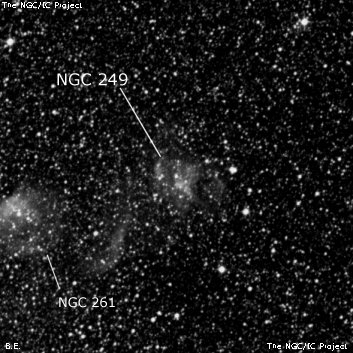
James Dunlop possibly discovered NGC 249 = D 19? = h2346 on 5 Sep 1826 with his homemade 9" speculum reflector and recorded "a small faint elliptical nebula - this is the preceding in a line of small faint nebulae." His position is just 3.7' N of this SMC nebula, although his positions can be all over the map, so assigning a specific object is difficult as NGC 261 is close following.
JH recorded this nebula on 3 sweeps, first logging "faint, large, round; very gradually brighter in the middle; 2' across. Here begins a starry region of the Nubecula Minor." The second observation reads: "pretty bright, pretty large, oval, resolvable, 2' diameter." The last notes are "faint, round, 30 arcseconds." Herschel notes that this entry could refer to either Dunlop 19 or 21.
400/500mm - 18" (7/10/05 - Magellan Observatory, Australia): at 228x this SMC cluster with nebulosity appeared fairly bright, fairly large, slightly elongated, 1.3'x0.9', weakly concentrated. Two or three faint stars are involved including a mag 13 star just north of the center. The UHC filter produces a good contrast boost and increased the size to at least 2'. Forms a pair with NGC 261 4.5' ESE with NGC 242 18' S.
600/800mm - 25" (10/17/17 - OzSky): NGC 249 is the first of four striking, collinear SMC nebulae and clusters with NGC 261 5' ESE, SMC-N19 10' ESE and SMC-N30 15' ESE. At 244x it appeared fairly bright, large, roundish, ~1.5' diameter. A few individual stars were superimposed. The view with a NPB was superb as the contrast was increased as well as the size to over 2'. NGC 249 resides in a gorgeous region of the SMC with a bright background due to the star density. This nebula contains one of only 12 known Wolf-Rayet stars (SMC AB 10) in the SMC.
Notes by Steve Gottlieb